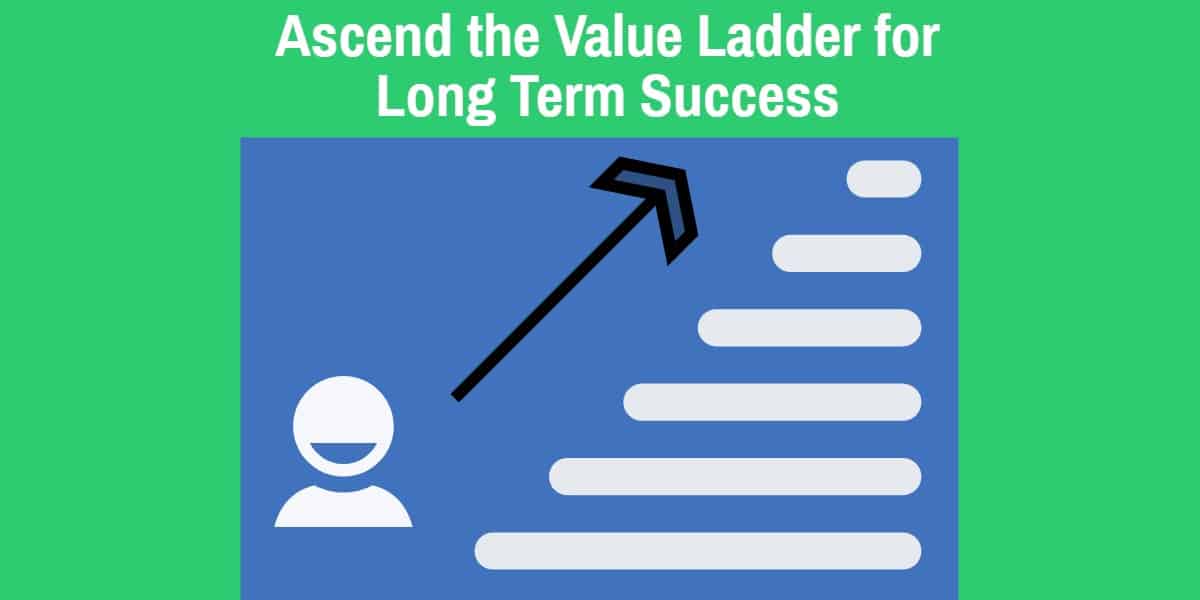What is the Value Ladder?
As simply as I can put it, the value ladder concept is this: Bring in a new customer on a low ticket, low resistance product or service. Then, over time you elevate them to higher ticket items that either compliment, or are symbiotic with, the first product or service you offered.
Remember the last time you went to the dentist for a regularly scheduled checkup? I do, and if your dentist is anything like mine you probably had a conversation something like this.
“Are you a smoker?”
“What?” I responded, “No. I’ve never been a smoker!”
“Well, I noticed that your teeth are turning a little yellow… Maybe you drink coffee?
“Well, sometimes I do…” I said, “Are my teeth really that yellow?!”
I didn’t realize it at the time, but this dentist was using the value ladder strategy. I came in for a simple check-up and teeth cleaning after receiving a card in the mail and ended up leaving having also gotten a whitening done, and with a stack of papers about the benefits of braces under my arm!
Will This Work for My Unique Business?
Whenever I talk to small business owners about this concept, I always hear the objection that this strategy won’t work for their business. The truth is, it will, you just have to get creative! Many businesses with this objection usually have the same problem – They only have one product or service. If this is you, don’t worry, I guarantee that if you look hard enough at your business you can come up with at least two more auxiliary products or services you can sell.
Let’s look at another example to see how it could work. Roofing Company ABC does new construction, replacement roofs, repairs and focuses on residential homes. Although it may sound like they offer multiple services at first glance, they only offer one. Putting new roofs on. This can be a problem because it is a very high-ticket service, and the average person typically doesn’t replace a roof for 20 years or more. They are missing out on a lot of opportunities here.
For example, they run an advertisement that offers repair or new roof construction. At any given time, only about 3% of people will be ready to buy when they see that ad, and maybe they will get one new job from the campaign if the targeting is perfect. On the other hand, suppose they run an ad that offers a free information product, like a report titled “How to Properly Prepare Your Roof for Winter”. By doing this they will not only attract the people who need a new roof now, but also those who are concerned or interested in this problem.
Now that you have attracted a much larger group of potential customers, you should assume that not all these people need or want the same thing. So, here is where the value ladder comes in. These people all have indicated interest by giving you their information in exchange for the report. The first offer you could make is to winter-proof their roof for them at a price point of maybe $500. The next step in the value ladder could be to offer a recurring, twice yearly cleaning and moss protection plan for maybe $1,200 a year. Keep in mind that this is extremely powerful because you now have a recurring revenue stream. The final step in the ladder will be your initial offer, a new roof or repair.
By offering multiple services at different price points you don’t miss out on all the opportunity that exists before someone is ready to buy your main service or product. I would assume that out of 100 people you would be lucky to get even 1 who is ready for a new multiple thousand-dollar roof, but maybe there are 15 who will take you up on winter-proofing, and another 5 who will purchase your yearly cleaning and moss protection plan.
Over time a certain amount of people who purchased your lower level services or products on the value ladder will ascend the ladder and also purchase your higher-level items because it is the natural logical progression. If you have had Roofing Company ABC winter-proof your house for the past 5 years, then who will you call when it’s time to replace the roof?
This same kind of strategy can be used for almost any business in almost any industry. Whether you own a retail shop, construction, medical, fitness, finance, real estate, food or online-based business – it can work for you.
Why Use the Value Ladder Strategy?
A primary reason it is smart to use the value ladder strategy in your business is that it essentially makes a money printing machine out of your marketing if done right. You’ve heard the phrase, “The fortune is in the follow-up” right? Well, it’s true! Let’s look at the McDonald’s model to see how this works.
It costs McDonald’s $1.91 in advertising to get you into the drive-thru. If you just buy a cheeseburger at $2.09, they make a measly 0.18 cents. But there’s that infamous tag line that we all know, “Would you like fries and a coke with that?” Every time someone says yes, they make another $1.77, which translates to $1.32 profit – 8 times the initial profit per sale. This is a value ladder strategy that happens at lightning fast speed.
Apart from the obvious benefit that offering a low-ticket item up front will get you more customers than offering a high-ticket item right off the bat, this model also allows you to outspend your competition on advertising and marketing. The name of the game is to break even on what it costs to acquire a customer by offering a low-ticket item up front and then to escalate them to your core products through follow-up, where everything you make will be profit.
Another important element here is that when you acquire a customer, it is an opportunity to interact with them and provide exceptional service. Even though you may have only broken even with their purchase, you now have that opportunity to build trust, respect and rapport with them. Instead of making just another one-and-done sale, you have a customer for life. But that is a topic for another article.
Until Next Time!
I know we have covered a lot in this article and although it can be tough to cover such a large idea in such a restrained format, I hope you have gotten some value from this. If you have any questions or want more information on how you can implement this strategy and others like it into your business, give us a call or schedule a free demonstration on our website. I truly appreciate you taking the time to read this and encourage comments and recommendations on what you would like to learn more about in the future!





